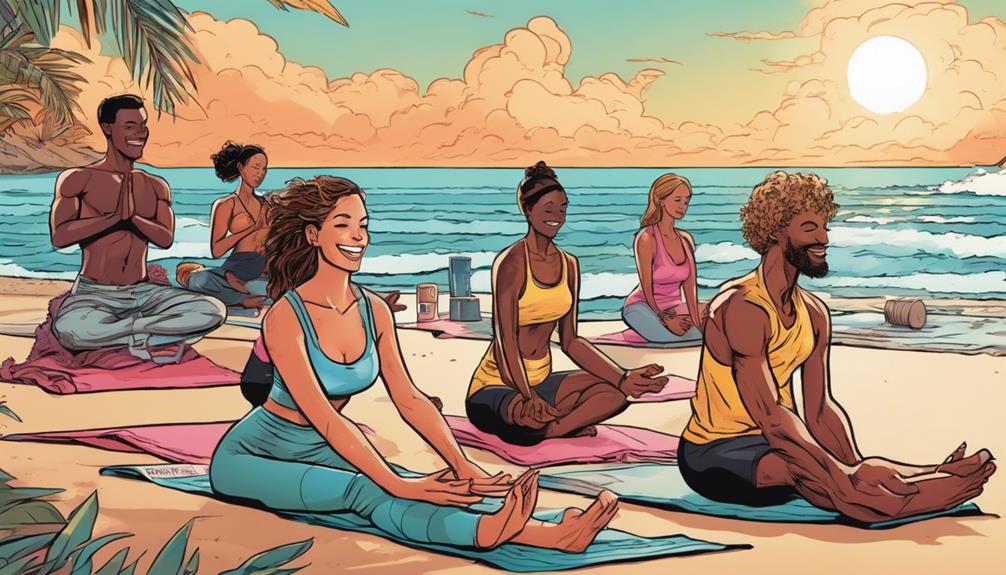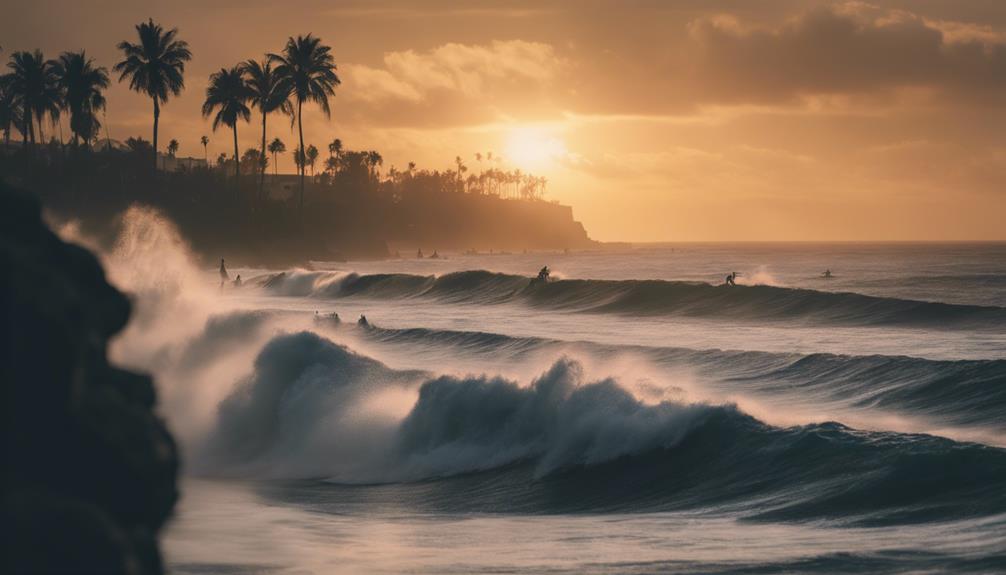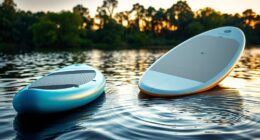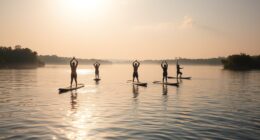If you're chasing the ultimate thrill, Chicama, Peru is where you want to go. It's home to the longest surfing wave in the world, stretching an incredible 2.5 miles. You can ride this wave for up to four minutes, making it a dream for any surfer. With five distinct sections, each ride offers something unique, catering to various skill levels. The ideal conditions usually happen between March and November, ensuring clean, impressive swells. Whether you're a novice or a pro, you're bound to have an unforgettable experience here, and there's plenty more to discover about this surfing paradise.
Key Takeaways
- Chicama, Peru boasts the longest surfing wave, stretching approximately 2.5 miles and allowing rides lasting up to four minutes.
- The Pororoca tidal bore in Brazil offers unique surf experiences with rides lasting 37 minutes over 12.2 km.
- Ideal surfing conditions at Chicama occur from March to November, featuring consistent swells for optimal riding.
- Chicama's five distinct wave sections cater to different skill levels, enhancing surfers' experiences and skill development.
Overview of the Longest Waves
When it comes to surfing, the longest waves in the world offer exhilarating rides that can last several minutes and stretch for miles. Among these, the longest surfing wave is found at Chicama, Peru. This stunning wave stretches approximately 2.5 miles (4 km) and allows surfers to enjoy rides lasting up to four minutes. Imagine gliding along such a lengthy wave, feeling the rush of the ocean beneath you as you carve through the water.
While Chicama holds the title for the longest surfing wave, other remarkable waves deserve mention. For example, Pavones in Costa Rica offers thrilling left-hand waves that can last up to three minutes, perfect for surfers seeking a challenge. Meanwhile, Pororoca in Brazil boasts an incredible tidal bore wave, where experienced surfers can ride for a staggering 37 minutes over 12.2 km (7.4 miles).
Other notable spots include the Gold Coast's Superbank in Australia, which provides a connection from Snapper to Kirra, enabling a total ride length of about 2 km (1.25 miles). Each of these locations offers a unique surfing experience, but Chicama's lengthy rides remain unparalleled.
Chicama: The Ultimate Surfing Destination

Chicama stands out as the ultimate surfing destination, offering unparalleled rides and diverse wave sections that cater to surfers of all skill levels. You'll find the longest surfing wave in the world here, stretching an incredible 2.5 miles (4 km). With five distinct sections—La Isla, El Cape, El Point, El Hombre, and El Pueblo—you can experience unique riding challenges and enjoy endless waves.
| Wave Section | Length | Skill Level |
|---|---|---|
| La Isla | 1 mile | Beginner to Intermediate |
| El Cape | 0.5 miles | Intermediate |
| El Point | 1 mile | Advanced |
The ideal surfing conditions at Chicama occur from March through November, when you can catch the best swells produced by distant storms. Thanks to its sandy bottom and occasional rocky areas, you'll find high-performance waves that are perfect for power surfing techniques. Plus, as the first wave in Peru's Protected Waves Registry, Chicama's quality is carefully preserved, ensuring you a first-rate surfing experience every time you hit the water.
Surfing Conditions and Techniques

When you're out at Chicama, you'll want to focus on the ideal wave characteristics and how they affect your riding techniques.
Understanding local surf etiquette is just as important, especially in a spot known for its long rides.
Let's break down what makes this legendary wave special and how you can make the most of it.
Ideal Wave Characteristics
To catch the longest waves, surfers should look for conditions that combine consistent swells, sandy bottoms, and distinct sections that cater to various techniques.
At Chicama, you'll find some of the longest waves for surfing on Earth, allowing for rides up to 2.5 miles and lasting up to four minutes. The wave's five sections, including La Isla and El Hombre, present unique riding experiences that enhance your skills.
Prime wave characteristics include a sandy bottom interspersed with rocky areas, creating high-performance waves suitable for power surfing techniques, especially during larger swells.
From March through November, you'll experience ideal surfing conditions, as large swells approach the coast nearly parallel, ensuring consistent, clean waves. This time frame is perfect for maximizing your ride.
To truly enjoy these waves, remember that respect and etiquette are key in the surfing community. Sharing waves with local surfers not only enhances your experience but also fosters a positive atmosphere.
Riding Techniques Explained
Understanding various riding techniques is essential for maximizing your performance on the long, powerful waves at Chicama. The unique sandy bottom, combined with rocky areas, creates high-performance waves that are perfect for power surfing techniques.
As you navigate the five distinct sections—La Isla, El Cape, El Point, El Hombre, and El Pueblo—you'll encounter different challenges that require varied riding techniques.
Backside wave riding shines here, thanks to the wave's clean, soft-flowing walls. It allows you to maintain speed and control throughout your extended rides, which can last up to four minutes. To make the most of these lengthy sessions, it's imperative to conserve energy while executing dynamic maneuvers.
Focus on your positioning and balance; these elements are essential for adapting to the wave's changing conditions. Harnessing the right riding techniques not only enhances your performance but also increases your enjoyment of Chicama's legendary waves.
Local Surf Etiquette
Respecting local surf etiquette is essential for ensuring a positive experience at Chicama, where the waves attract both seasoned surfers and newcomers alike. By following a few simple guidelines, you can foster a respectful atmosphere and enjoy the ride.
Always respect wave priority; the surfer closest to the peak has the right to take off first.
Avoid dropping in on local surfers already riding a wave; it's not just unsafe, but it disrupts the flow of the session.
Remember that sharing waves is encouraged, especially when the crowd gets thick; taking turns can lead to more enjoyable rides for everyone.
Being mindful of your positioning in the water helps maintain safety and respect among surfers.
Communicate with fellow surfers when necessary to avoid collisions, and always be aware of your surroundings.
This not only enhances your experience but also builds camaraderie within the surfing community.
By embracing these principles, you'll find that the waves at Chicama become even more enjoyable, as everyone works together to create a positive surfing environment.
The Pororoca Tidal Bore Experience

Have you ever experienced the thrill of riding the Pororoca, a tidal bore that transforms the Brazilian Amazon into a surfer's paradise for just a few days each year? This incredible phenomenon occurs typically between February and March, allowing surfers to catch waves that can last up to 37 minutes over a distance of 12.2 km (7.4 miles). With the power of 6,000 jet engines, the Pororoca offers a unique surfing experience that's unlike anything else.
As you prepare to ride, you'll notice the dramatic changes in the river's shape, with natural debris and wildlife—yes, even piranhas—presenting challenges along the way.
Local communities celebrate this event with rituals that highlight the cultural significance of the tidal bore, showcasing their deep connection to this impressive natural wonder. These local rituals not only honor the waves but also bring together surfers and locals in a shared appreciation for the Pororoca.
Environmental Protection in Surfing

Protecting our beloved surfing spots is crucial not just for the waves we ride, but for the ecosystems that support them. When surfers advocate for environmental protection, they're also safeguarding the health of surf ecosystems that are essential to local marine life.
To make a real impact, focus on these key aspects:
- Support conservation efforts: Engage with organizations like Save the Waves Coalition, which work tirelessly to promote sustainable practices and community initiatives.
- Preserve iconic waves: The designation of Chicama as Peru's first Protected Wave in 2013 shows how government action can protect unique surfing conditions from development.
Surf Culture and Community

Surf culture thrives on a deep sense of community, where surfers from all walks of life come together to celebrate their love for the ocean and the sport. Places like Chicama exemplify this camaraderie, uniting surfers from around the globe who share the thrill of riding the longest wave. Events such as pro tour competitions and wave pool contests not only highlight surfing as a professional sport but also enhance the vibrant surf community.
In La Libertad, El Salvador, the welcoming surf culture attracts a diverse crowd, creating a friendly environment for surfers of all skill levels. Notable figures like musician Jack Johnson show how intertwined surf culture is with artistic expression, further enriching this community. Additionally, initiatives from organizations like Save the Waves Coalition emphasize the importance of preserving our ocean ecosystems, ensuring that future generations can enjoy quality waves.
Here's a glimpse into surf culture and community:
| Aspect | Description |
|---|---|
| Camaraderie | Strong bonds formed among surfers |
| Inclusivity | Welcoming to all skill levels |
| Events | Pro competitions and local contests |
| Artistic Influence | Musicians like Jack Johnson inspired by surfing |
| Environmental Focus | Conservation initiatives within the community |
Frequently Asked Questions
What Is the World Record for the Longest Time Surfing a Wave?
You'd be amazed to learn that the world record for the longest time surfing a wave is 37 minutes. It showcases incredible skill and endurance, pushing surfers to their limits in pursuit of that record-breaking ride.
What Is Chicama Wave?
Chicama wave, in northern Peru, is famous for its incredible length and ideal surfing conditions. You can ride its five distinct sections, experiencing unique challenges and thrills, especially between March and November when swells are perfect.
Has Anyone Surfed a 100 Foot Wave?
Imagine surfing a towering wave like a scene from a sci-fi movie. Yes, surfers have ridden 100-foot waves, with António Laureano's incredible 101.4-foot ride in Nazaré, showcasing the extreme limits of this thrilling sport.
What Is the Biggest Wave Ridden at Nazare?
The biggest wave you've seen ridden at Nazaré was by António Silva on October 29, 2020. It measured an incredible 30 meters (98 feet), showcasing the immense power of Nazaré's unique underwater canyons.
What Makes Peru the Perfect Destination for the Longest Surfing Wave?
Surfers flock to Peru for the ultimate adventure – riding the longest surfing wave in peru. With consistent swells and perfect breaks, the coastal region offers some of the best surfing conditions in the world. Add in stunning scenery, vibrant culture, and delicious cuisine, and it’s easy to see why Peru is a top destination for surfers.
Conclusion
In the world of surfing, chasing the longest wave is like dancing with the ocean—each ride a unique story waiting to unfold.
Whether you find yourself gliding along Chicama's endless stretch or feeling the rush of the Pororoca, the thrill of the wave keeps you coming back for more.
Together, let's cherish this vibrant culture while protecting our beloved waters, ensuring that future surfers can experience the same exhilarating ride that captivated you.










